COVID-19 update: Fourth confirmed case for Bloomington city employees comes amid local uptick; nursing home releases data
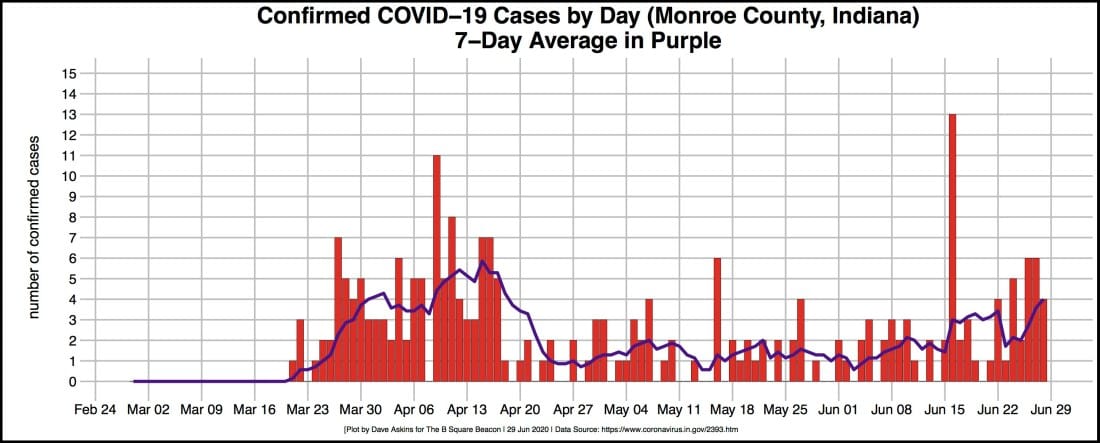

On Monday, the city of Bloomington issued a press release announcing that a fourth city employee had tested positive for COVID-19.
It was the second positive test for a city employee in the last five days, both of them firefighters. The previous two tests came nearly three months ago. Those were for a firefighter and a parks and recreation staffer.
Helping to provide a clearer picture of what’s going with local COVID-19 numbers has been the regular release of figures from the Golden LivingCenters facility since the beginning of June.
The two city worker cases come during a two-week period that has seen the rolling 7-day average for cases in Monroe County increase to four cases per day. The 7-day average had previously stayed under two cases a day since the third week in April.
The state’s department of health COVID-19 dashboard shows that testing in the county has increased over the last few months, as it has across the state. Some of the increase in confirmed cases might be analyzed as due to increased testing, but testing has been on the rise for a couple of months.
In May, the number of Monroe County tests (2,358) more than doubled compared to April (1,014). With the month not yet over, Monroe County has already seen almost 50 percent more tests in June (3,441) than in May (2,358).
In the last three weeks, Monroe County averaged 923 tests a week compared to 627 tests in the previous three weeks. That’s 50 percent more tests in the last three weeks compared to the previous three.
So, some of the increase in cases could be related to the relaxation of state-wide and local restrictions on the size of gatherings and the offering of dine-in service by restaurants.
The age distribution of positive cases in Monroe county in the last week and a half, from June 17 through June 27, shows a higher share of cases for the 20-29 age group and the 80+ age group than from the start of the pandemic through June 17.
For the same periods statewide, the 20-29 age group also shows a higher share of positive cases for the most recent 10-day period than it did up to that point.
Compared to the rest of the state, Monroe County continues to show a lower percentage of positives among all tests done. In Monroe County, the rolling daily average rate of positive tests rates has stayed mostly under 2 percent. The statewide rolling average finally declined to around 4 percent in mid-June but is starting to turn upward.
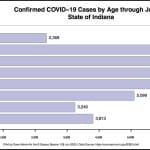
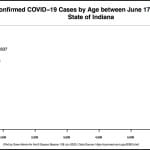
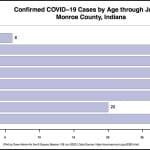
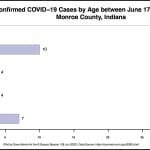
Monroe County’s higher death-to-positive-cases ratio
A statistic that stands out for Monroe County is its higher ratio of deaths-to-positive-cases than for the rest of the state. In Monroe county as of Monday June 29, that stat stands at 11.8 percent (28/237) compared to 5.4 percent for the rest of the state. (2,432/45,228).
If more of those who are testing positive in Monroe County are also high-risk, vulnerable patients, like those who live in nursing homes, that might help explain the higher incidence of deaths compared to confirmed positive cases.
But checking nursing home COVID-19 numbers has been a challenge in Indiana, as the state has declined to release facility-by-facility numbers. They are released in aggregate. And the CMS (Centers for Medicare & Medicaid Services) database figures aren’t necessarily accurate, as CMS acknowledges.
The CMS website states: “This is preliminary data and may be subject to fluctuations as facilities are given the opportunity to submit and correct their data on the NHSN website.” In one initial data release the CMS database showed a local Bloomington facility with more COVID-19 positive cases than it had beds. That facility is now codes as not meeting the data quality control standard.
The current CMS database doesn’t show any deaths due to COVID-19 for Bloomington or Ellettsville facilities, except for Golden LivingCenters. And that figure doesn’t match the number that Golden LivingCenters now releases directly to the public on its website, which is 17 total deaths.
About those deaths, Golden LivingCenters said in a statement to The Square Beacon, “[O]ur team is deeply grieving the loss of our 17 residents who lost their battle with COVID-19.”
If the 17 deaths and 98 positive cases at Golden LivingCenters Bloomington location are subtracted from Monroe County’s totals, that gives a somewhat lower deaths-to-positive-cases ratio: 7.9 (11/139) instead of 11.8 percent. But if the state’s long-term care numbers are peeled off the total, that gives 3.2 percent (1,266/39,886), which leaves Monroe County’s modified ratio still at more than double the state’s quotient.
Even if it doesn’t offer an easy explanation of Monroe County’s higher deaths-to-positive-cases ratio, the numbers on the website for Golden LivingCenters offer some clarity about what’s going on at the 23 buildings operated by the company across Indiana.
Earlier in the pandemic, the Golden LivingCenters data was password protected, made available just to families of patients. Asked who made the decision to open the website to public view, Wesley Rogers, president of GLC’s Indiana operations, told The Square Beacon, “That came from me.”
Rogers said “It’s the right thing to do,” adding that it’s important to be as transparent as possible. “The numbers are what they are,” Rogers said.
The statement from GLC describes how seven patients at the Bloomington facility, who are over age 90, recovered from COVID-19 since the first COVID-19 resident was identified in May.
Rogers described to The Square Beacon how the GLC’s COVID-19 task force spends several hours a week coordinating their response across their Indiana facilities. The statement says, “Each day presents us with information that we must respond to in order to minimize the spread of the virus and focus on the health and safety of our staff and residents.”
The statement also thanks the families of residents: “We cannot say enough about the families and community members who are supporting us with their kind words of encouragement, gifts and donations, parades, and most of all patience. Their overwhelming support fuels our healthcare heroes and helps us continue this fight.”




Comments ()